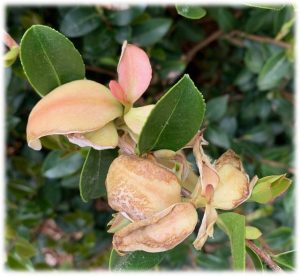Q. Some of the leaves on my azalea and/or camellia are swollen and light green. What caused this?
A. This is caused by a fungus that has been relatively common this spring.
The fungus Exobasidium vaccinii causes leaves and flowers to become swollen or thickened, curled and waxy in appearance. This fungus causes leaves, and in some cases flower petals, to enlarge abnormally and is commonly referred to as azalea or camellia leaf and flower gall.
Symptoms vary somewhat based on the host plant. In addition to azalea and sasanqua camellia, it can occur on blueberry, as well. Infected blueberry leaves turn an unusual bright red in spring with almost no swelling of tissue. With azaleas and camellias, leaves become large and distorted and eventually a white powder covers the galls. The white growth consists of spores, which is how the fungus reproduces. Galls ultimately turn brown and harden. Not every leaf will be infected. It’s more common for the plant’s lower leaves to be the most heavily infected but under humid conditions and in shaded locations galls may form on leaves throughout the plant canopy.
The disease relies on airborne spores produced in the whitish mold on the surface of galls in late spring to early summer to reproduce. The galls then form the following spring. It’s important to remove and dispose of infected leaves before they turn white with spores.
Once you see evidence of infected leaves, it’s too late for chemical control. Besides, there currently is no effective or practical fungicide to control this disease in the home landscape. But you can reduce the amount of infection on your plants the following year by pruning infected leaves and throwing them away before spores are produced. After removing infected leaves with galls, never leave them on the ground around the plants.
It’s best to bury, burn or place the infected leaves in a plastic bag and throw them away. This disease is more severe during a cool, wet spring. It’s advisable to not add to the problem by artificially providing the “wet weather” the spores need by frequently using an overhead sprinkler and keeping the foliage wet in the spring during disease development. This is exactly what this and many other plant diseases need – wet conditions. Yet another reason to water during early morning and on an as needed basis, versus allowing an irrigation system to frequently run when there is already adequate moisture from rain.
In the home landscape, the fungus does not cause any long-term problems for the plant. It just makes the plant’s leaves look ugly. The infected leaves will usually fall prematurely.
- Evaluate and Renovate Landscape During Fall - October 30, 2025
- Summer is Too Hot for Lawn Herbicides - August 23, 2025
- Nuisance Gnats abound in Northwest Florida this spring - June 26, 2025

